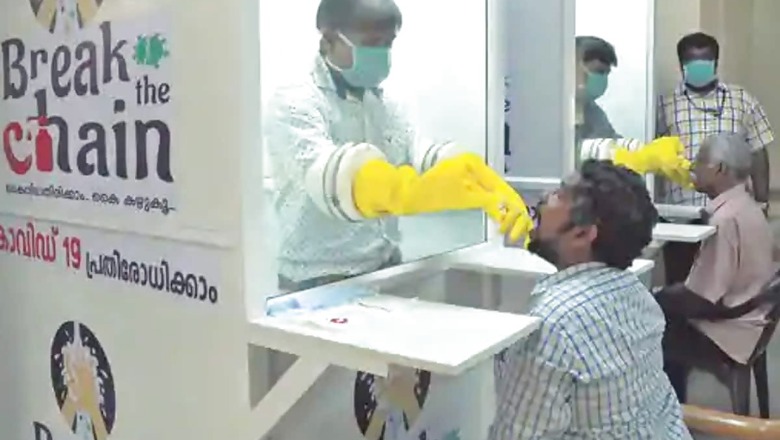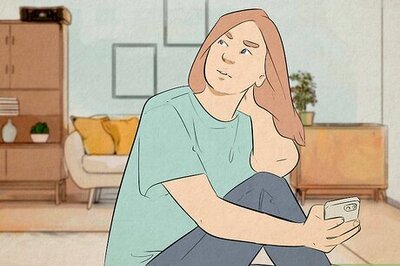
views
On October 10, Kerala, which recorded the first Covid-19 case in the country, had a rare feat, though not an enchanting one considering its position in the health sector. In the number of daily cases, it topped the country, at 11,755. If it took 180 days between January 29, 2020, and July 28, to reach 10,000 total active cases, in another 70 days, it crossed 10,000 cases a day. On October 7, the once model state became the fourth state in the country after Maharashtra, Andhra Pradesh, and Karnataka to cross 10,000 cases a day. “The period up to November is critical,” said chief minister Pinarayi Vijayan after the daily expert committee meeting. “Remember, we could delay the spread of the disease at its peak. We could maintain the death rate at the lowest rate in the country due to our efforts, ” he said.
The state government, which received many a laurel in the international arena, was quick to blame it on the public protests by the opposition Congress and BJP when it became one of the top three states in new Covid-19 cases per million population, per week, as it registered 158 cases in the week from September 19-26.
There was even a campaign on social media by the ruling front terming the opposition as “merchants of death”. Curiously the death rate in the state is still low and the government is highlighting this instead of the number of cases when the latter showed a humongous increase.
“It is baseless to blame it on the opposition and public protests. You must remember what the chief minister and the health minister predicted in August that the number of cases would be between 10,000 and 20,000, much before the political uprisings. The number of cases was less in the state when the number of tests was less. Remember, once we were in 19th position in the testing. Naturally, the cases increased in proportion to the tests,” MLA and veteran Congress leader VD Satheesan told News 18. He also criticized the ruling front for indicting the opposition for the public gathering by taking the examples of the gatherings by the ruling front including the funeral of a controversial leader in Kozhikkod district.
Hence, there arises a range of questions on what happened in the state which was basking in glory and its health minister was even hailed as “Covid slayer” when other parts of the globe were grappling with the worst fear in its memory.
Here are the various phases in Kerala’s 37-week Covid combat:
January 30 – March 8
The first case in the country was reported in Kerala on January 30, 2020, in a student who returned from China. The state was able to contain the three cases which reached the state in two days.
March 9 – May 8
No new cases were reported until March 9. Phase two began with the cases detected by a team of diligent doctors at a government hospital, reported from Italian returnees in Pathanamthitta who reached the state on February 28. This phase was very crucial for the state as panic gripped over the procedure of how the cases and the route map was detected.
May 9 – June 7
When interstate and intercountry travel was allowed, Keralites in foreign countries started reaching Kerala in large numbers. There was a rise in the number of cases that were predicted. Until May 31, no traces of community spread were identified.
June 8 – July 5
Unlock 1.0 started as the lockdown was removed on June 8 and confined only to containment zones.
July 6 – August 16
This phase is crucial as political allegations gained space in media over the pandemic with the gold smuggling through diplomatic channels at Thiruvananthapuram airport was unearthed on July 6. Incidentally, a weeklong triple lockdown was declared in Thiruvananthapuram Corporation on the same day after several cases turned up without a specific origin of infection.
August 17 – September 5
The Malayalam month of Chingam, an auspicious period, and the season of marriages started. The government had fixed the number of persons attending the marriage and functions; people cleverly manipulated this and started arranging functions where people assembled in shifts. Hence, the attendance, in reality, was many times more than stipulated.
September 6 – September 26
The number of cases doubled as 1,00,000 cases and 371 deaths reported during these 21 days
September 27 – October 10
It became one of the top three states in new Covid-19 cases per million population, per week when it registered 158 cases in the week from September 19-26. It crossed 1,000 cases twice during the period with once at the daily top position.
Experts, as usual, differ in their views on this matter and term it too early to write off the fight.
“On October 7, the number of daily Covid patients had crossed 10,000 and the test positivity rate went up to 13 to 14 percent. However, on October 8, the rate came down to 8.4 percent as only 5,445 out of 63,146 tested positive. Many asked me whether it is a sign of the spread getting reduced. It is too early to say that,” said Dr B Ekbal, chairman of the expert committee to advise the government on Covid-19 management and a member of the state planning board.
According to statistical experts, the sudden change in trends is described as “statistical noise” or “secular trend”. “It would be more scientific if we took the weekly moving test rate by adding the last six more days, rather than taking the daily test positivity rate. Hence, we have to wait for the data from the coming days to arrive at a more accurate evaluation,” Dr. Ekbal said.
The state government authorities see a ray of hope even when the number of cases is rising and reject the allegation of ‘ premature celebration’ claiming victory against the pandemic.
“See, we have to understand the density of the state is almost double that of India. We cannot compare Kerala with countries like Sweden and it is not an island that you can isolate everyone who got infected to conquer the pandemic,” said Dr. Mohammad Asheel, executive director of Kerala Social Security Mission under the government’s social justice department.
“According to me, Kerala has two achievements. One, our mortality rate is low, which is a bigger achievement. Then it could delay the peak more effectively than other states. Though the national lockdown also had the same purpose, Kerala was able to delay it much further by combining lockdown with other public health measures such as effective quarantine. However, you cannot delay this permanently. Expatriates started returning. People are moving from different parts of the country and the contacts are increasing daily. Despite our announcements, many had a casual attitude on regulations. Due to all this, at some point, the numbers will rise. At the end of the day, the question is not on the number of patients, but how many survived. The more important thing is not whether daily numbers are going above 10,000, but whether our public healthcare system can deal with 10,000 cases every day. I think Kerala has done well in all these months to strengthen its capacities, so it is now in a much better position to deal with the rise in numbers, ” he said.
Dr. Asheel also ruled out the allegation ‘ premature victory celebration. ” The celebrations were intended at giving a boost to our health workers who were working relentlessly. Any achievement, big or small will have a positive impact on the team. How can you paint it in a negative tone?” he asked.
However, not everyone is ready to buy these arguments and they pinpoint the shortcomings which went unnoticed.
“It is not correct to call it a trend by looking at the data of one or two days. Then our comparison is also wrong. Kerala’s performance should be compared to countries like Sri Lanka, which is similar in size and geography. This is a new disease. The death rate is lower here. It cannot be termed as a credit of the government,” said Dr. SS Lal, a US-based health expert and head of public health at Global Public Health Institute.
“There is also another side to this. The number of serious patients, who need ventilator support and ICU was less here. It could be a specialty of the virus and this is a matter to be studied. But there is no data on how many here had to depend on the ventilator. I learned that 90 percent of those who reached the ventilator stage died. That data is not made public and it is wrong. We celebrated the initial victory out of proportion and it led to chaos. On a personal note, my mother is a victim of this confusion in healthcare caused by the Covid situation. The authorities don’t have any clue,” said Dr. Lal who is also the president of the state unit of All India Professionals’ Congress.
“There is no corrective force within the team. We need a team. Initially, the number of patients was low. Even then we had warned earlier itself that the number would go up. When there is no medicine or vaccine available for a disease, the only tool for controlling is a proper communication strategy. We did this in the case of HIV which changed the perception about the disease and the patients. Here, what is the communication strategy? Many speaking in different voices will not help in any way to contain the pandemic.”
It looks like the public, who were eager to return to normal life started normal public behavior as the restrictions were lifted leaving the ‘ new normal’ way behind. The case of Malappuram can be taken as an example of this. According to statistics and district health authorities, the Eid celebrations on July 29 to August 1 had an impact on the spread. Now, Malappuram alone contributed more than 1000 plus patients on seven days during the fortnight from September 29.
“Everywhere people started returning to normal life once they got the results of the pandemic. The data such as the mortality rate is low and it could be read according to how we need to. We have to imagine the speed of multiplication. The speed of transmitting from person to another is the same as it takes to transmit from one lakh to two lakh,” said Dr. Rajeev Jayadevan, president of the Indian Medical Association’s Kochi chapter.
According to Dr. Padmanabha Shenoy who is tracking the epidemic with daily data, the method had some shortcomings. “We were focusing on quarantine and not on testing. When it came to the matter of containment zones, we did not test everyone. Then those asymptomatic ones from the area went out and mingled freely which led to a spread. This is a pandemic that can be contained only with the cooperation of society. Hence, we have to focus on getting the confidence of the public rather than imposing measures which alienate them,” said Dr. Shenoy.
According to Dr. CJ John, a veteran psychiatrist and a social observer, the spread has a connection with society’s health behavior and approach to public health. “Matters such as immunization are part of one’s vigilance on a personal level. Of course, it is good and hence we are ahead of others in many health indices. However, in the case of Covid, mere personal vigilance is not enough. To win in an epidemic situation, especially in a state like Kerala, where it is densely populated from north to south like a long township, personal health should be interwoven with a drive to social change,” said Dr. John.
Read all the Latest News and Breaking News here














Comments
0 comment